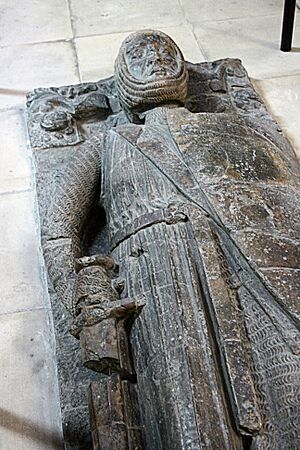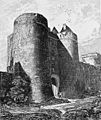William Marshal, 1st Earl of Pembroke facts for kids
William Marshal (born around 1147, died May 14, 1219) was a famous English knight. He served five different kings of England! William was known for his amazing fighting skills, his strong loyalty to his kings, and his talent for solving problems peacefully. He started his life as a knight without much land or money, but he became the Earl of Pembroke and one of the richest men in England.
After William died in 1219, his oldest son asked someone to write a book about his father's life. While biographies sometimes make things sound better than they were, many of the stories about William are also found in other historical records.
Contents
William's Early Years
William Marshal's father was John Marshal, also known as John the Marshal. He was the Lord of Newbury Castle in England. When William was a young boy, England was in a terrible civil war. This war was between King Stephen and Empress Matilda, who both believed they should be the ruler. This time was called "The Anarchy" because there was a lot of lawlessness and fighting. Many powerful lords would switch sides if it helped them, and John Marshal did too. He first supported King Stephen, but then he changed his loyalty to Empress Matilda.
Becoming a Knight
At a young age, William was sent away to learn how to be a knight. He was officially made a knight in 1166. Then, he traveled to Normandy (in modern-day France) to serve his uncle, Patrick, the Earl of Salisbury. In 1168, William fought bravely in a battle where his group was greatly outnumbered. His uncle was killed, and William was captured. But William's courage and skill were noticed! Queen Eleanor of England paid a ransom to free him.
As a young knight, William often went to tournaments. These were like contests or pretend wars where knights competed for big prizes. Tournaments were a way for knights to win money, horses, armor, and weapons. They were also very dangerous, and sometimes knights were even killed during them.
Serving the Young King Henry
William became a very skilled knight. After he was freed, he joined the household of King Henry II. William helped train other men to fight. He became a teacher, protector, and friend to King Henry II's son, who was known as Henry the Young King. When young Henry was crowned, William was chosen to be the captain of his guards and the chief of his knights. It was William who officially made the young Henry a knight.
William also went with young Henry to many tournaments. In 1173, young Henry argued with his father because he wanted to become king while his father was still alive. He left England and went to his mother's lands. In 1174, Henry II and his son made peace. William continued to gain fame in tournaments. Sadly, the young king became sick and died suddenly in 1183.
Crusades and Fighting for Henry II
Before he died, young Henry asked William to go on a Crusade for him. A Crusade was a religious war fought in the Holy Land. With King Henry II's permission, William went on a Crusade for two years. His amazing fighting skills were recognized by the Knights Templar, a famous group of warrior monks.
When William returned, King Henry II was very happy and made him an important member of his household. William then fought for Henry II against the King of France. He also fought against Henry's other sons, who were rebelling against their father.
Richard, another son of Henry II, also wanted to be King of England and didn't want to wait for his father to die. In one fight, William came across Richard. Instead of killing Richard, William killed his horse. Soon after, Henry II became ill and died in 1189.
Serving King Richard I
Richard, who became King Richard I (also known as "Lionheart"), remembered William's bravery and loyalty. When Richard became king, he took William with him to fight against the King of France. After a while, Richard decided to go on a Crusade himself. He left William in England as the Justiciar, which meant William acted for the king and oversaw the king's courts while Richard was away.
King Richard also kept a promise his father had made to William. He gave William the right to marry a wealthy heiress who owned the Earldom of Pembroke and other lands. This instantly made William one of the richest men in the kingdom, with property in four different countries.
William fought bravely for King Richard against the King of France and was there when a peace treaty was signed. In 1199, King Richard was wounded and died. After his death, there was another argument about who should be the next King of England: Richard's nephew Arthur or his brother John.
William believed that John, as Richard's brother, should be the next king, following the customs of the time. The decision was made in John's favor, and he became the next King of England.
William and King John
William fought alongside King John. After some time, John made William the Marshal of England, a very important position.
King John was not liked by many of his powerful lords. He knew this and didn't trust them. When William went to Ireland to protect his lands there, King John made him give one of his sons as a hostage. This was to make sure William stayed loyal. King John sometimes took lands away from William and then gave them back. There was a lot of trouble during King John's rule, but William remained loyal to the king throughout.
King John died on October 18, 1216. His son, Henry III, was too young to rule the kingdom. So, William Marshal was chosen to be the Regent for Henry III. This meant William would make decisions for Henry until he was old enough to rule himself.
William and King Henry III
William was quite old by this time, but he managed the kingdom's affairs as Regent for Henry III. He even fought in a battle at Lincoln when he was about 70 years old! William Marshal died on May 14, 1219, at Caversham.
William Marshal's Death
When William knew he was dying, he put on the special robe of a Knights Templar. After his death, he was buried in the Temple Church in London. You can still see a stone carving, called an effigy, of William Marshal at the Temple Church in London, with his son's effigy next to him.
Images for kids
-
Memorial in Cartmel Priory
-
Inverted shield of William the Marshal with his obituary and epitaph, drawn by Matthew Paris.
See also
 In Spanish: Guillermo el Mariscal para niños
In Spanish: Guillermo el Mariscal para niños





